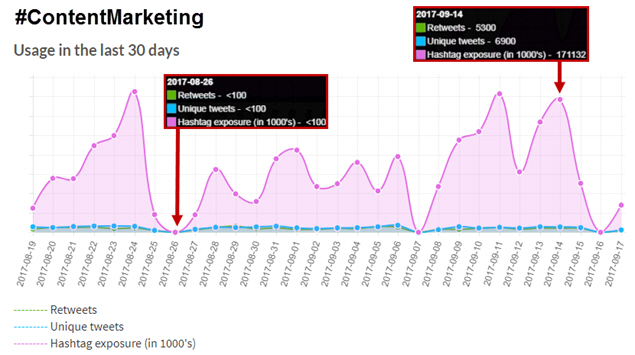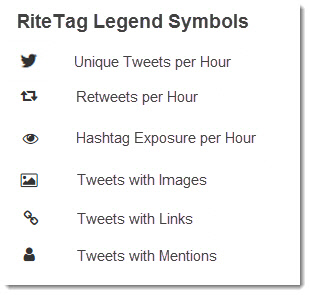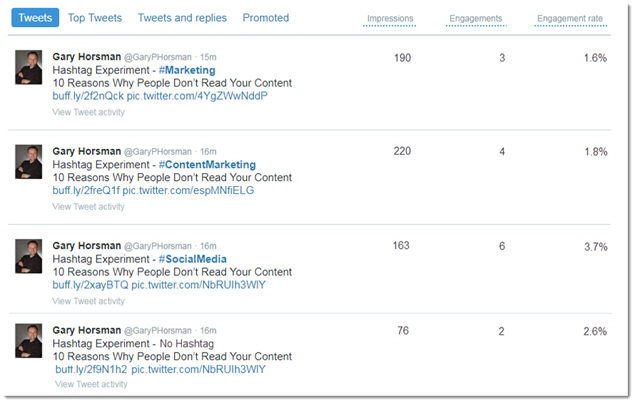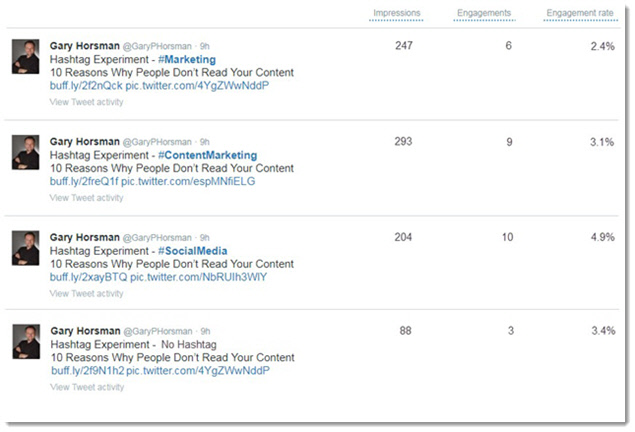Twitter Tips – Using Hashtags
Short and Longer Term Value of Hashtags

Leveraging Hashtags on Twitter
A hashtag is a word or phrase that is written without any spaces and prefixed with a ‘#’ symbol. Like so: #example
The word Hashtag (#) has become so significant that it was added to the Oxford Dictionary in 2014. The actual hashtag definition says: “a word or phrase preceded by the hash sign (#) used on social media websites, especially Twitter, to identify messages on a specific topic”.
Hashtags can be a very powerful tool to promote your content on Twitter. Of course, they can be used to help you find things – which means they act like a search engine on Twitter. But this “search-like” function for hashtags is fundamental to helping you gain more exposure for your tweets as other people use hashtags to find your content.
Use Hashtags to Promote Your Content on Twitter
How Do You Know Which Hashtags To Use?
You can create your own hashtags which should be done on occasion.
However, it may be more impactful to use a hashtag that is already being used by other people. These “other people” represent a specific niche market. If you are interested in this niche and they may be interested in the content you can provide then hashtags make the connection for both. If you support this “hashtag niche” with your entertaining, inspirational, and informative content then the connection via a hashtag or set of hashtags works perfectly for both parties.
To make an analogy, this is just how search engines work and we know how valuable their function is. You have some delightful content. Someone is searching for that content using a keyword phrase and the connection between the content creator and the content seeker is made by the search engine. Twitter and a hashtag (or two) is similar in nature to this seek and find process. That is why knowing hashtags (which ones, use volume, competition, etc.) is so valuable.
Hashtag Research
I use RiteTag to do hashtag research.
RiteTag lets me know the popularity of a given hashtag and the make-up of tweets using that hashtag. Moreover, RiteTag provides information on the level of competition for any given hashtag.
For example, RiteTag shows me how many times a specific hashtag is used per hour. This is valuable. A popular hashtag (many tweets per hour) may seem like the one to use but it may have more competition from other people using the same hashtag. A hashtag with fewer people using it is therefore not as competitive (which is good for you as the competition is lower) but may result in less exposure (perhaps not so good). You need to balance both exposure and competition when deciding which hashtag(s) to use.
RiteTag can help you to know your hashtags well.
Here is an example for the hashtag “#ContentMarketing”.

First, I want to note that if you used RiteTag on August 26th to do your analysis you would gain a different understanding for this hashtag than if you did your research on September 14th. It is wise to view hashtag metrics over time to see if there are large variations.
For example, When I study the hashtag #Blogging using Ritetag I observe a similar variation over time.
Here is a view of the hashtag analysis for #ContentMarketing. I know this hashtag well and it is a popular hashtag on Twitter even with the variation.

 For the hashtag #ContentMarketing, the exposure level can be very high as over 2 million people could possibly see your tweet.
For the hashtag #ContentMarketing, the exposure level can be very high as over 2 million people could possibly see your tweet.
However, there are 267 tweets per hour (over 4 tweets per minute) so your tweet will move down in the twitter feed for this hashtag quickly.
Therefore, it is important to know the variation in exposure and competition with time and it is also important to know whether the tweets have images and links and how active and engaged the audience is (retweets and mentions).
You should know these details for any hashtags that you use regularly. This analysis needs to be part of your marketing.
Using Different Hashtags and Watching Over Time
To illustrate how the selection of hashtags can impact the effectiveness of your tweet I did the following experiment which studied the use of 3 different hashtag terms and one tweet with no hashtag. I observed exposure and engagement at after 15 minutes and after 9 hours.
Experiment Details: Same tweet, same image, same time, different hashtags with one tweet being sent without any hashtag.
Here is the RiteTag analysis for each hashtag term.
Table 1

I composed the tweets in advance and then published them all during the same minute.
Special Notes
1. I often use the hashtag #ContentMarketing. This means that the Twitter hashtag algorithm may work in my favor providing me with more exposure, for this hashtag, relative to the other two hashtags, than Table 1 (above) may suggest. I use the hashtag #ContentMarketing often so this helps my exposure level when I use this hashtag as I am a frequent user of this hashtag.
2. The hashtag #ContentMarketing is probably the most relevant to the tweet and the associated content. The Twitter algorithm may, again, favor the tweet using the #ContentMarketing hashtag as the hashtag and the tweet content are well-matched.
3. The hashtag exposure level as reported by RiteTag shows that the hashtags “Marketing” and “SocialMedia” are much more competitive. So even though the potential exposure appears to be higher for these two hashtags the competition level is also higher and tweets using either of these two hashtags will have more tweets to compete with.
You want exposure and engagement for tweet effectiveness. It is often better to select hashtags that help the tweet gain both exposure and engagement. Now, that said, the highest engagement percent was for the tweet with the hashtag “SocialMedia”. This was true at both 15 minutes and at 9 hours.
The experiment shows that hashtag selection must be done with care and that one must balance exposure, tweet content relevancy, and engagement carefully to maximize the effectiveness of your hashtags.
Here Are the Actual Experiment Results
After 15 minutes – the “normal tweet lifespan” I looked at my Twitter Analytics. There was a difference in the impression level ranging from 163 impressions for the hashtag SocialMedia to 220 for the hashtag ContentMarketing. This higher level for the tweet with #ContentMarketing is most likely explained by exposure filtering by the Twitter algorithm.
Table 2 – After 15 Minutes

As noted above, part of the intention for using a hashtag is to help people find content when they are searching for tweets using a hashtag. To gain insight into the “search value” of a hashtag I looked at my Twitter Analytics for these 4 posts at the 9-hour point and each tweet had received more exposure. That means that people were using the hashtag associated with the three tweets to help them find this content. From 15 minutes to 9 hours more people were exposed to these three tweets because they searched for the content using a hashtag.
The tweet that did not have a hashtag could only gain more exposure as a result of people searching through my tweets. To search through my tweets is much more time-consuming and also random as you really don’t know if there is a specific tweet on a specific topic or where it may be in the timeline. Moreover, even though the tweet may gain exposure, without the hashtag focus the exposure may not be very relevant.
Using hashtags helps people find niche content and helps your niche content to be found. Being specific for your audience is valuable in marketing. Hashtags help to be specific.
Table 3 – After 9 Hours

The total exposure for the three tweets after 15 minutes was 573. The total exposure after 9 hours was 744. This is a 30% increase in exposure. This extra exposure is most likely related to people using the hashtag to find and sort through tweets on the topic of the hashtag. The people that represent the extra 30% did not see it when the tweet was initially posted.
Note that the engagement rate went up. This is a clear indication that people were searching for something specific related to the hashtag.
Therefore, a hashtag helps in both the short term – the “normal” short lifespan of a tweet – and helps the longer-term life of a tweet – when people use a hashtag to conduct a search.
10 Hashtag Ideas
Hashtags help us to communicate on Twitter.
The bottom line is that it is very helpful to use hashtags relevant to your topic. They can help people to find content and can help a tweet get more exposure with a specific audience. Here are some hashtag use ideas.
1. Use hashtags that are very relevant to your tweet. The hashtags you select for any given tweet should provide relevant information about your tweet.
2. Know your industry hashtags and use them properly.
3. Use hashtags offline. Consider using them on:
- Signs and posters

- Articles in a magazine or newspaper
- Off-line ads
- A business card or in a brochure
- Heavy stock and hand them out at seminars and events
- Billboards
- The big screen at your local movie theater
4. Use a hashtag that is related to your content and that is also trending. This is difficult to do but can result in massive exposure levels.
5. Monitor the hashtags that are being used by your competitors. Learn what they are doing and saying on Twitter.
6. If you are on social media platforms other than Twitter and hashtags are used on these other platforms then do your homework to study how to best use hashtags on these other platforms. Note that what may be best practice on Twitter may not work well on another platform.
7. Hashtags are not case-sensitive but by adding capital letters you can make your hashtags easier to read. (#makeawish versus #MakeAWish)
8. Use hashtags to join a conversation. If you are watching a conversation about something and want to join in then add that topic’s hashtag(s) to connect your Tweet to the broader conversation. By adding the hashtag, it increases the chance someone interested in the event will find and engage with your Tweet.
9. Marketing is about defining your ideal niche audience and then focusing on it so that you create inspirational, entertaining, and informative content just for them. Do hashtags research for this ideal audience as part of your niche marketing research. Focused marketing is more powerful than broad marketing.
10. Use location-based hashtags if your tweets are about a specific location. Examples would be B&Bs, Real Estate Agents, Tour Guides, Restaurants, and Resorts.
Conclusion
Hashtags are very important on Twitter as they help people to find tweets on a topic of interest to them. Therefore, you are providing a service to the people that follow you and that are interested in tweets on a specific topic by knowing which hashtags to use and using them properly.
Hashtags have both short and long-term value.
Do your hashtag homework to help more people find your delightful content. This helps them and you!
To be informed about tweets on Twitter Tips follow me on Twitter @GaryPHorsman and use the hashtag #TwitterTips. You can also use this link to see all posts on this blog in the category Twitter Tips. I am expanding content in this area of interest.
If you have comments or suggestions for other Twitter Tips posts then use the comment field below – thanks!
